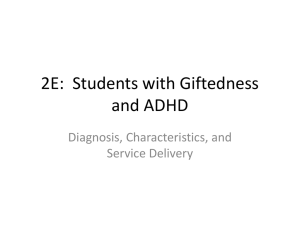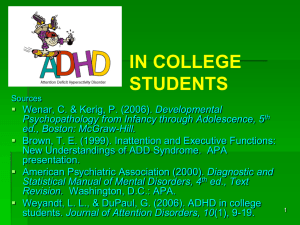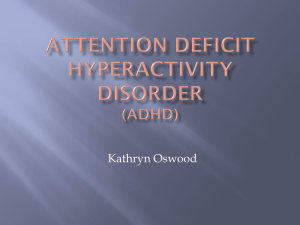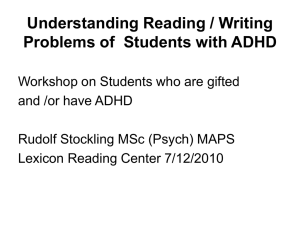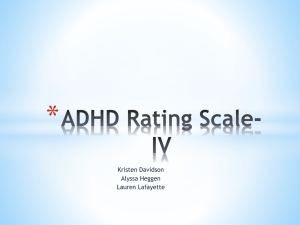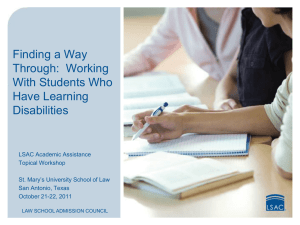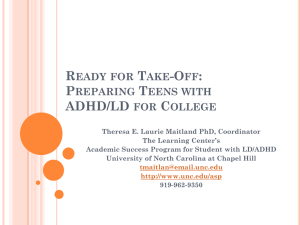All That Wiggles Is Not ADHD History, Classification, and Diagnosis
advertisement
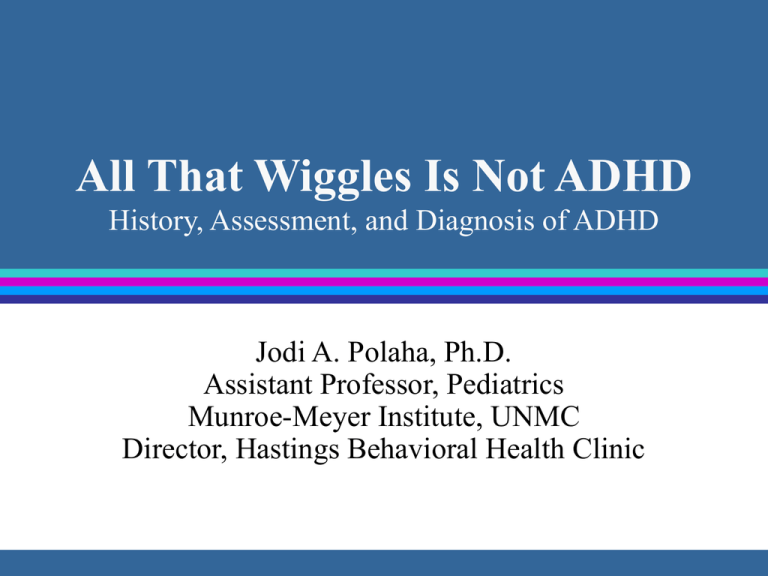
All That Wiggles Is Not ADHD History, Assessment, and Diagnosis of ADHD Jodi A. Polaha, Ph.D. Assistant Professor, Pediatrics Munroe-Meyer Institute, UNMC Director, Hastings Behavioral Health Clinic Attention-Deficit Hyperactivity Disorder History: Where did ADHD come from? “Defects in Moral Control” George Still, M.D. (1902) A “cluster” of behaviors which: were more common in males seemed to run in families were associated with certain congenital anomalies were not accounted for by any known neurological deficit Other Names/Classifications Post-encephalic Brain Disorder Brain Injured Child Syndrome Minimal Brain Dysfunction Hyperkinetic Reaction of Childhood (DSM-II) Attention-Deficit Disorder (DSM-III, 1980) Current Conceptualization Attention-Deficit Hyperactivity Disorder (ADHD) DSM-IV, 1994 Three subtypes: Predominantly Inattentive Predominantly Hyperactive/Impulsive Combined Adolescent and Adult Outcomes Some symptoms into adolescence: 70% Some symptoms into adulthood: 50% At increased risk for: Substance abuse Traffic citations Automobile accidents Cause of ADHD No one cause identified. Not caused by Diet (i.e. food additives, sugar) Poor parenting Other Myths/Misconceptions ADHD is outgrown in adolescence. Other Myths/Misconceptions ADHD is outgrown in adolescence. Girls are not hyperactive. Other Myths/Misconceptions ADHD is outgrown in adolescence. Girls are not hyperactive. There is a single test for ADHD. Other Myths/Misconceptions ADHD is outgrown in adolescence. Girls are not hyperactive. There is a single test for ADHD. Stimulant medication can “diagnose” ADHD. Other Myths/Misconceptions ADHD is outgrown in adolescence. Girls are not hyperactive. There is a single test for ADHD. Stimulant medication can “diagnose” ADHD. There is a “cure” for ADHD. Prevalence of ADHD Best current estimate: 3%-5% school age population are affected. Attention-Deficit Hyperactivity Disorder Diagnosis: Who has ADHD? Formal Diagnostic Criteria DSM-IV, 1994 Criterion A: Six or more symptoms from one or both of these lists: Inattentive Type Hyperactive/Impulsive Type …have been present for at least 6 months. Symptom Lists Inattentive Type fails to attend to details, makes careless mistakes difficulty sustaining attention in play or work does not listen when spoken to does not follow through difficulty organizing tasks avoids task requiring sustained mental effort loses things needed distracted by extraneous stimuli often forgetful Hyper/Impulsive Type often fidgets hands/feet or squirms often leaves seat when sitting is expected runs about or climbs excessively difficulty playing or engaging in leisure activities quietly often “on the go”/ “driven by motor” talks excessively blurts out answers before questions completed difficulty awaiting turn interrupts or intrudes on others Formal Diagnostic Criteria DSM-IV, 1994 Criterion B: Some of the symptoms were present before the age of seven years. Formal Diagnostic Criteria DSM-IV, 1994 Criterion C: Some impairment from the symptoms is present in two or more settings (e.g., home, and school or work). Formal Diagnostic Criteria DSM-IV, 1994 Criterion D: There is evidence of clinically significant impairment in social, academic, or occupational functioning. Formal Diagnostic Criteria DSM-IV, 1994 Criterion E: The identified symptoms are not better accounted for by another mental disorder. Attention-Deficit Hyperactivity Disorder Assessment: All that wiggles is not ADHD Comprehensive Diagnosis for ADHD There is no single test or laboratory measure which can reliably detect ADHD. Comprehensive Diagnosis for ADHD Information gained by qualified clinician: From family standardized, norm-referenced ratings detailed history Comprehensive Diagnosis for ADHD Information gained by qualified clinician: From family standardized, norm-referenced ratings detailed history From school standardized, norm-refernced ratings academic history in-class observations Comprehensive Diagnosis for ADHD Information gained by qualified clinician: From family standardized, norm-referenced ratings detailed history From school standardized, norm-referenced ratings academic history in-class observations From clinician observations Other Common Causes of Concentration Problems Depression/anxiety Other Common Causes of Concentration Problems Depression/anxiety Drug/alcohol use Other Common Causes of Concentration Problems Depression/anxiety Drug/alcohol use Poor fit between academic demands and individual’s capabilities Other Common Causes of Concentration Problems Depression/anxiety Drug/alcohol use Poor fit between academic demands and individual’s capabilities Physical illness Other Common Causes of Concentration Problems Depression/anxiety Drug/alcohol use Poor fit between academic demands and individual’s capabilities Physical illness Adjustment Associated Problems Learning Disability: 25 - 30% Associated Problems Learning Disability: 25 - 30% Oppositional Defiant Disorder: 35 - 65% Oppositional Defiant Disorder Pattern of negative, hostile, and defiant behavior: Often loses temper Often argues with adults Often actively defies or refuses to comply with adults’ requests or rules Often deliberately annoys people Often blames others for his/her mistakes or behavior Often touchy or easily annoyed by others Often angry or resentful Often spiteful or vindictive Associated Problems Learning Disability: 25 - 30% Oppositional Defiant Disorder: 35 - 65% Variable academic quality Associated Problems Learning Disability: 25 - 30% Oppositional Defiant Disorder: 35 - 65% Variable academic quality Poor social skills, peer relationships Who Has ADHD? Percent 100 90 80 70 60 50 40 30 20 10 0 Extremely Attentive 3-5% Average Attentiveness Extremely Inattentive Who Has ADHD? Percent 100 90 80 70 60 50 40 30 20 10 0 Extremely Attentive 3-15%? 3-5% Average Attentiveness Extremely Inattentive ADHD as Heterogeneous Disorder Inattentive Type Hyper/Impulsive Type fails to attend to details, careless mistakes difficulty sustaining attention in play or work does not listen when spoken to does not follow through difficulty organizing tasks avoids task requiring sustained mental effort loses things needed distracted by extraneous stimuli often forgetful often fidgets hands/feet or squirms often leaves seat when sitting is expected runs about or climbs excessively difficulty playing or engaging in leisure often “on the go”/ “driven by motor” talks excessively blurts out answers before questions completed difficulty awaiting turn interrupts or intrudes on others Associated Problems Learning Disability Oppositional Defiant Disorder Variable academic quality Poor social skills, peer relationships ADHD as Heterogeneous Disorder Inattentive Type Hyper/Impulsive Type fails to attend to details, careless mistakes difficulty sustaining attention in play or work does not listen when spoken to does not follow through difficulty organizing tasks avoids task requiring sustained mental effort loses things needed distracted by extraneous stimuli often forgetful often fidgets hands/feet or squirms often leaves seat when sitting is expected runs about or climbs excessively difficulty playing or engaging in leisure often “on the go”/ “driven by motor” talks excessively blurts out answers before questions completed difficulty awaiting turn interrupts or intrudes on others Associated Problems Learning Disability Oppositional Defiant Disorder Variable academic quality Poor social skills, peer relationships ADHD as Heterogeneous Disorder Inattentive Type Hyper/Impulsive Type fails to attend to details, careless mistakes difficulty sustaining attention in play or work does not listen when spoken to does not follow through difficulty organizing tasks avoids task requiring sustained mental effort loses things needed distracted by extraneous stimuli often forgetful often fidgets hands/feet or squirms often leaves seat when sitting is expected runs about or climbs excessively difficulty playing or engaging in leisure often “on the go”/ “driven by motor” talks excessively blurts out answers before questions completed difficulty awaiting turn interrupts or intrudes on others Child with ADHD Associated Problems Learning Disability Oppositional Defiant Disorder Variable academic quality Poor social skills, peer relationships Child with ADHD Importance of Diagnosis Can help schools document need for additional services. Research purposes. Professional communication. But it doesn’t help individualize a treatment strategy! Importance of Diagnosis More important than a diagnosis: is a comprehensive, functional assessment of the child’s impairment in daily life • • • • with peers. with teachers. with siblings. with parents. New Conceptualization of ADHD Dr. Russell Barkley: “ADHD is a delay in the development of behavioral inhibition.”

